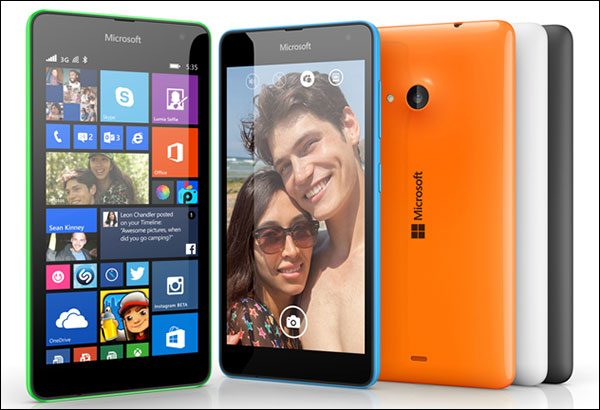Microsoft on Tuesday announced the Lumia 535 — the first smartphone under its own brand since it completed its acquisition of Nokia in April.
Microsoft is marketing the 535 as its “5x5x5” smartphone package. It has a 5-inch screen and 5-MP front- and rear-facing cameras.
Microsoft will offer both single-SIM and double-SIM versions.
Both will be 3G phones, preloaded with Windows Phone 8.1 and the Lumia Denim update.
Denim, codenamed “Debian Red” during development, is the latest firmware for Lumia handsets. It offers new capabilities including 4K video, various other enhanced camera features, and a passive-listening version of the Cortana personal digital assistant.
The Lumia 535 will be available later this month in select markets for about US$140, but here’s a hint: It’s priced in euros, which indicates it might not come to the United States soon.
The 535 and its predecessor, the Nokia Lumia 630, underscore Microsoft’s increased focus on affordable smartphones in an effort to target the fastest-growing segment of the market.
The Lumia 535’s Features
“Just to call this a low-cost phone doesn’t mean it has to be a low-quality device,” Ramon Llamas, a research manager at IDC, told TechNewsWorld. “The 535 doesn’t look or feel like a cheap handset, it’s very feature-packed.”
The device has a capacitive multipoint-touch IPS LCD qHD display with a resolution of 960 x 540 pixels. The scratch-resistant Gorilla glass display has brightness control, tactile feedback, an orientation sensor, and enhancements for greater readability in sunlight.
The standard smartphone features — maps and navigation apps, video and audio recording and playback, music apps — are all there.
The 535 runs on a 1.2 GHz quad-core Qualcomm Snapdragon 200 processor.
It has the usual sensors, and Microsoft is throwing in 15 GB of free cloud storage.
The 535 has a device lock, a device lock passcode, a PIN code, application sandboxing, integrated antiphishing, remote device wipe via Internet, secure boot, and various enterprise security features.
What it doesn’t have is anything “that stands out,” remarked Jeff Orr, a senior practice director at ABI Research.
There is nothing that “is going to see this particular model driven towards the most advanced mature markets, such as the United States, Western Europe, Japan or South Korea,” he told TechNewsWorld.
The Road Less Traveled
By offering the Lumia 535 under its own imprimatur, Microsoft is “trying to keep its hardware all unified under one brand name,” Llamas suggested. “You’ve got the Xbox, the Surface and now the Lumia all carrying its brand.”
Brand-strengthening, which CEO Satya Nadella has established as a priority, will help Microsoft tackle the competition.
“They will have to fight Samsung and HTC in the Windows Phone pool,” Llamas pointed out. “By having the Microsoft brand on the 535, it indicates there are Microsoft elements built into this.”
Microsoft has strong digital imaging capabilities, which “you won’t find on Samsung and HTC phones,” he pointed out.
However, Microsoft could stub its toe.
“Based on the configuration, this is part of Microsoft’s value-based offering, so in markets such as India, where Nokia has had a reasonable presence and a reasonable amount of brand recognition, Microsoft has to be able to get consumers to equate Microsoft to Nokia,” Orr said.
Microsoft’s Direction
To some extent, Microsoft’s mobile strategy is based on the groundwork laid by former CEO Steve Ballmer, who ordered the Windows Phone OS rewritten from scratch after WinPho 6, taking the hit for the delay to market.
“You can give Ballmer some credit for seeing what’s happening in the market and adapting accordingly instead of following Microsoft’s original strategy of forcing the market to accept smartphones as extensions of the desktop,” Tuong Nguyen, an analyst at Gartner, told TechNewsWorld.
Granted, Nadella is focusing strongly on mobile, Nguyen said, “but it hasn’t been too long — and we have yet to see the true impact of his leadership.”






















































